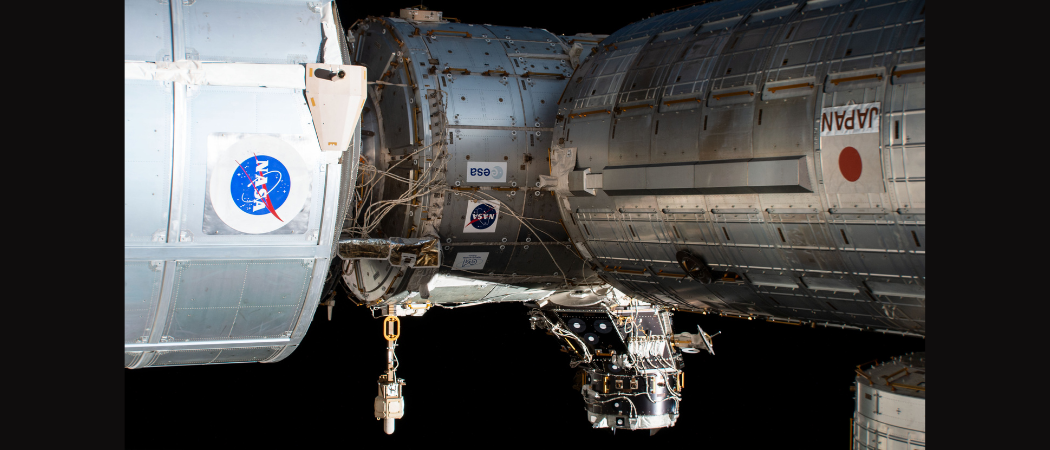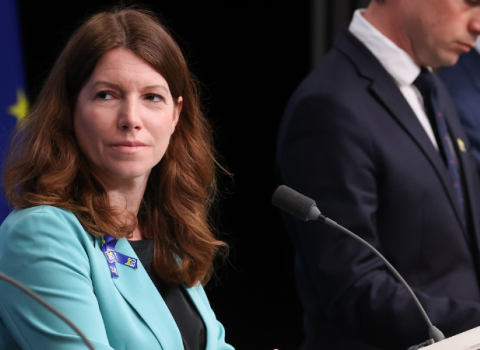As the first private mission to deliver instruments to the moon for NASA crashes back to earth, ESA gives further details of its plan to work with industry to develop an independent cargo return vehicle

The European Space Agency's logo can be seen on the forward-end of the International Space Station (ISS). Photo: NASA Johnson Flickr
The European Space Agency will sign contracts with industry in May 2024 for the development of a vehicle to take cargo to the International Space Station (ISS) and back to earth, as a first step towards a model pioneered by NASA to reduce demands on public funding, whilst at the same time promoting development of a commercial space sector.
“We have been studying a lot what’s been going on in the US,” said Luca Del Monte, head of commercialisation at ESA. NASA’s approach to privatisation has allowed the US space agency to “limit the risks and reduce the costs” and to “enlarge the industrial basis by including new players,” he told a conference on commercialisation in space exploration at ESA’s Space Research and Technology Centre (ESTEC) in Noordwijk, Netherlands, today.
ESA wants to adopt the NASA mindset in which, “the evaluation of the proposal is not just based on the technical assessment but also on business plans,” Del Monte said. That will include adopting NASA’s staged milestone payment structure, and putting in place a “robust legal structure” that allows for the easy termination of contracts if companies fail to deliver.
However, ESA is aware that attracting private capital will require a significant financial commitment on its part. “The risk is clearly that we will have a failure of the procurement if we are not attractive enough with the budget,” said Del Monte.
That is the thinking behind the contracts, under which ESA will be providing €75 million and support to take two vehicles through to the demonstration phase.
ESA member states agreed at the Space Summit last November to launch a competition to develop a cargo vehicle by 2028, with the capabilities to service the ISS, but also suitable for adapting to deliver to other destinations in the future, as the agency looks to embrace a competition model.
“Every moment we waste widens the gap between what everyone else in the world is able to do and what we can do in Europe,” said astronaut Samantha Cristoforetti, the low earth orbit (LEO) cargo return service team leader, providing an update on the competition at the conference today.
The ISS is expected to cease operating by the end of 2030. “We do not want to find ourselves in a situation of being customers who have to buy services to fly astronauts - who have to buy astronaut time on commercial platforms of overseas industries,” Cristoforetti said. “We need to have something that our industry does, and the very basic one is this cargo resupply, that we can barter in exchange for astronaut flights, research and development opportunities in microgravity.”
Technical and financial milestones
The call for proposals, which closes on 29 February 2024, will lead onto the award of up to three contracts for the first phase of the programme. That will run from June 2024 to June 2026, with €75 million allocated from the existing ESA budget.
The second phase beginning in June 2026, will require contractors to stage a demonstration mission. That will require a larger budget, which will be decided at ESA’s next ministerial level council meeting in 2025. The agency is planning to award two contracts for this demonstrator, which could result in the procurement of recurring services.
Cristoforetti said ESA will be “very serious about terminating the contracts” if milestones are not achieved, either in terms of technical development or financial conditions such as fundraising.
The agency will be looking to avoid the kind of complications it has seen in launchers, with delays to Ariane 6 and Vega-C and a loss of access to Russian Soyuz rockets leaving Europe without sovereign access to space.
Ariane 6’s first flight is now planned for the summer, four years behind schedule. In the meantime, the EU is finalising a deal with the US private company SpaceX for the launch of two Galileo navigation satellites in April, and two more in July.
As the conference took place, the Peregrine spacecraft launched by the US company Astrobotic to take cargo to the moon for NASA, was being positioned for a controlled re-entry to earth somewhere over the South Pacific. Astrobotic worked with NASA to find the safest route to end the mission after the craft started leaking fuel and the engines stopped operating properly. Re-entry is expected at 10pm CET today (January 18).
As an illustration of the tensions that the public-private approach could generate, Astrobotic said that as commercial mission, the final decision on Peregrine’s fate was in its hands. “Ultimately, we must balance our own desire to extend Peregrine’s life, operate payloads, and learn more about the spacecraft, with the risk that our damaged spacecraft could cause a problem in cislunar space,” the company said when it announced it was ending the mission.
Low earth orbit
For now, ESA’s ambitions are to develop a low earth orbit service that can transport around four tonnes of cargo to the ISS, and two tonnes back to earth.
But the design should provide scope for the vehicle to evolve towards a crewed vehicle, and also to be able to return samples from Gateway, a proposed international outpost to be built around the moon, “without major modifications to its architecture,” the phase I call says.
“We're not specifying exactly what needs to be done in these two years. Industry will propose how they plan to do this,” said Cristoforetti. However, companies will have to set a timeline leading to a demonstrator by 2028.
The technical specifications are also open-ended. “Industry needs to decide what kind of service they want to put out there so that it is competitive with other similar services on the market, because we do not intend to be the only customers,” Cristoforetti said.
Bidders require a minimum non-ESA co-funding of 20% in phase 1, with a target of 40% overall. But ideally said Cristoforetti, this should be higher because ESA’s budget for phase I is small. This is because the overall ESA budget is only decided by ministers every three years, with the last meeting held in 2022.
Competition model
ESA has switched its strategy as it looks to secure Europe’s role in the burgeoning space economy. Alongside the cargo vehicle, it also plans to launch a competition for industry to provide a launch service, with no weight class limitation. ESA director general Josef Aschbacher proclaimed this as a “paradigm shift” in the way Europe secures its future access to space at November’s Space Summit.
Meanwhile, the agency is working with industrial partners on the Moonlight initiative, to provide commercial telecommunication and navigation services for lunar missions by putting a constellation of satellites around the moon.





 A unique international forum for public research organisations and companies to connect their external engagement with strategic interests around their R&D system.
A unique international forum for public research organisations and companies to connect their external engagement with strategic interests around their R&D system.